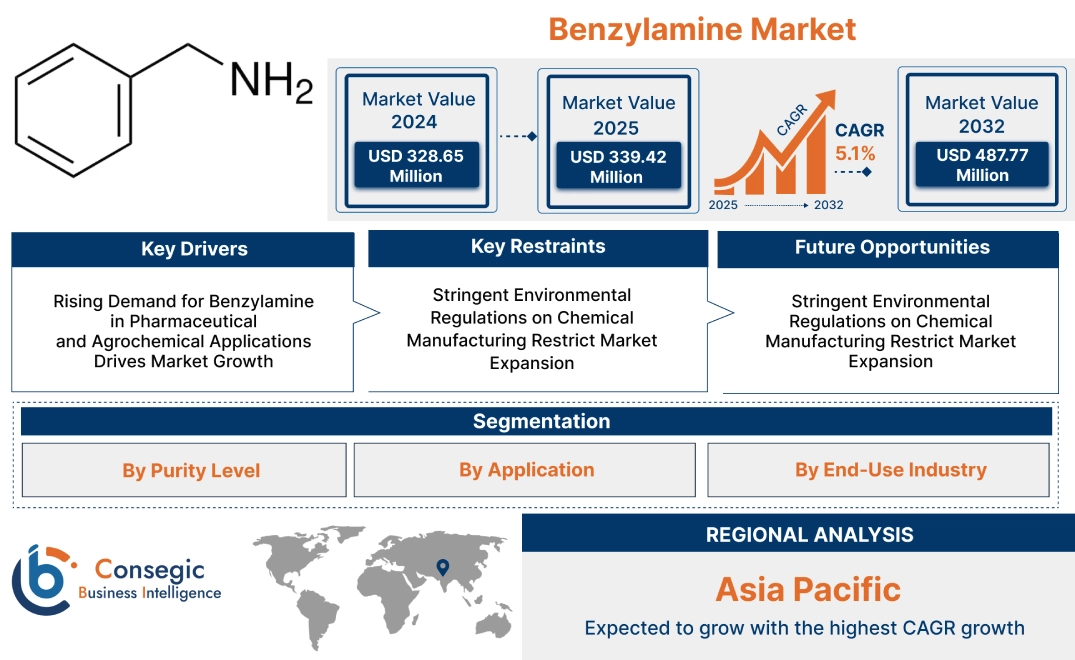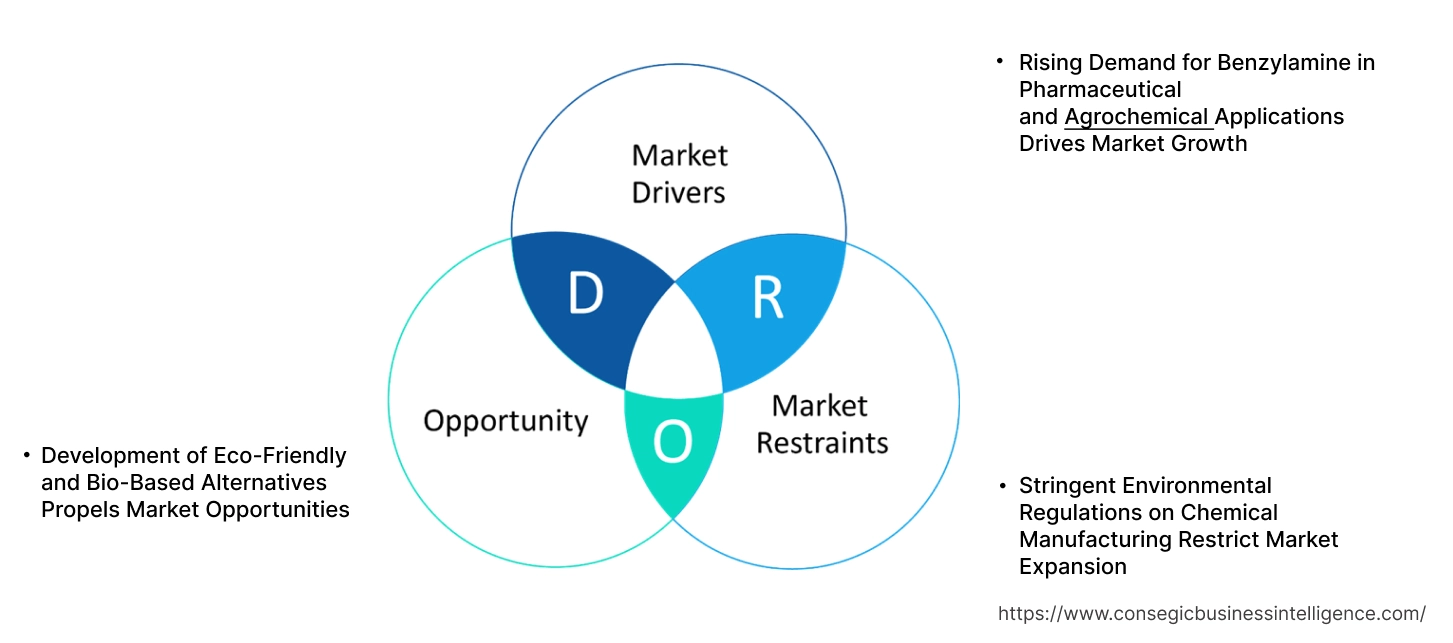- Summary
- Table Of Content
- Methodology
Benzylamine Market Size:
Benzylamine Market size is estimated to reach over USD 487.77 Million by 2032 from a value of USD 328.65 Million in 2024 and is projected to grow by USD 339.42 Million in 2025, growing at a CAGR of 5.1% from 2025 to 2032.
Benzylamine Market Scope & Overview:
Benzylamine is an organic compound derived from benzyl chloride through ammonolysis. Its molecular structure enables high reactivity, making it suitable for applications in chemical formulations and industrial processing. It plays a crucial role in the production of active pharmaceutical ingredients, corrosion inhibitors, and specialty coatings.
Its key features include strong nucleophilic properties, solubility in organic solvents, and stability under various reaction conditions. These characteristics contribute to its effectiveness in fine chemical manufacturing and catalytic processes. Its controlled reactivity ensures precise formulation in specialized applications.
Pharmaceutical manufacturers, chemical industries, and research institutions incorporate the chemical for its efficiency in developing high-performance compounds. Ongoing improvements in chemical synthesis continue to refine its application scope, ensuring consistent product quality and adaptability across multiple sectors.
Key Drivers:
Rising Demand for Benzylamine in Pharmaceutical and Agrochemical Applications Drives Market Growth
In pharmaceuticals, benzylamine serves as a key intermediate in the production of antibiotics, antihistamines, and other active pharmaceutical ingredients (APIs). The rise in global healthcare spending, drug innovation, and chronic disease management is fueling its widespread use in drug synthesis. Additionally, in the agrochemical sector, uses this chemical in the formulation of herbicides, fungicides, and pesticides, supporting high-yield farming and crop protection efforts. With the growing need for sustainable agricultural practices, the market for efficient and environmentally safer chemical solutions continues to expand. Governments worldwide are emphasizing the use of advanced agrochemicals to ensure food security, further strengthening market expansion.
- For instance, in May 2024, the India Brand Equity Foundation (IBEF) reported that the Indian agrochemical sector is expected to grow at a CAGR of 9% from FY25 to FY28 due to government support for the sector, expansion of production capacities by companies, increasing demand in both the domestic and export markets and introduction of new innovative products.
As industries seek high-performance chemical intermediates, these factors are expected to contribute significantly to benzylamine market expansion, reinforcing its importance in critical industrial applications.
Key Restraints:
Stringent Environmental Regulations on Chemical Manufacturing Restrict Market Expansion
Government agencies such as the EPA, REACH, and other regulatory bodies impose strict guidelines on emissions, waste disposal, and chemical safety, increasing compliance costs for manufacturers. Chemical plants are required to invest in pollution control technologies, energy-efficient production methods, and sustainable waste management solutions, leading to higher operational expenses. Additionally, restrictions on hazardous material handling and transportation create logistical challenges for suppliers and distributors. Companies that fail to comply with evolving environmental standards risk fines, production halts, or restrictions on market entry, impacting overall profitability. These regulatory hurdles are particularly challenging for small and mid-sized manufacturers, limiting their competitiveness. Overcoming these barriers through investment in green chemistry and regulatory compliance strategies will be crucial for ensuring benzylamine market growth and securing long-term sustainability in the industry.
Future Opportunities:
Development of Eco-Friendly and Bio-Based Alternatives Propels Market Opportunities
Industries are shifting toward renewable feedstocks and green synthesis methods to reduce dependency on petrochemical-derived raw materials. Advancements in biotechnology, enzymatic catalysis, and biomass-derived precursors are enhancing the efficiency and environmental compatibility of benzylamine production. Additionally, the growth of circular economy initiatives and corporate sustainability goals is encouraging manufacturers to adopt eco-friendly processing technologies. Governments and regulatory bodies are also supporting the transition to bio-based chemicals by offering incentives, tax benefits, and funding for green chemistry research. As industries seek low-carbon, non-toxic chemical solutions, the demand for biodegradable and renewable formulations is expected to increase.
- In August 2021, researchers at the Chinese Academy of Sciences demonstrated a sustainable production method of benzylamine from lignin. The process involved dehydrogenation, followed by hydrogenolysis and reductive amination in the presence of Pd/C catalyst.
These developments are set to create new benzylamine market opportunities, positioning bio-based solutions as a key driver for sustainable industrial applications.
Benzylamine Market Segmental Analysis :
By Purity Level:
By purity level, the market is segmented into below 99% purity, 99% - 99.5% purity, and above 99.5% purity.
The 99% - 99.5% purity segment held the largest benzylamine market share in 2024.
- This purity level is widely used in chemical synthesis, pharmaceuticals, and industrial applications, ensuring broad commercial use.
- The need for high-purity benzylamine is increasing, particularly in agrochemicals and corrosion inhibitors where purity enhances product efficiency.
- Market analysis highlights that advancements in purification techniques are improving consistency and effectiveness across industrial applications.
- For instance, Thermo Scientific supplies this chemical with 99% purity for pharmaceutical purposes at competitive prices.
- Thus, as per benzylamine market trends, manufacturers are investing in refining processes to ensure optimal product stability and reactivity.
The above 99.5% purity segment is expected to achieve the fastest CAGR during the forecast period.
- Ultra-high purity is crucial in specialized applications, including pharmaceutical formulations and high-end chemical synthesis.
- Its demand is rising, driven by stringent regulatory standards and the need for contamination-free chemical production.
- Segmental trends suggest that research into ultra-pure compounds is increasing, particularly in advanced materials and specialty chemicals.
- Therefore, with the expansion of precision chemical manufacturing, this segment is driving benzylamine market growth.
By Application:
Based on application, the market is categorized into strong base, chemical intermediate, and corrosion inhibitor.
The chemical intermediate segment held the largest revenue share in 2024.
- The compound is widely used as a key intermediate in pharmaceuticals, agrochemicals, and polymer production, ensuring its high market demand.
- Its requirement as a precursor in specialty chemicals is increasing, particularly in the synthesis of dyes, resins, and coatings.
- Benzylamine market analysis suggests that manufacturers are focusing on expanding their intermediate product lines, improving efficiency in downstream applications.
- Thus, as per segmental trends, increased investment in specialty chemical production is driving need for high-quality intermediates.
The corrosion inhibitor segment is anticipated to experience the fastest CAGR during the forecast period.
- It is widely used in industrial and oil & gas sectors to prevent metal corrosion, ensuring longevity in infrastructure and machinery.
- The need for effective corrosion inhibitors is rising as industries focus on extending the life of pipelines, storage tanks, and chemical processing units.
- Market trends suggest that eco-friendly corrosion inhibitors are gaining traction, reducing environmental impact in industrial applications.
- Therefore, with increasing investments in infrastructure and energy sectors, this segment is contributing to benzylamine market expansion.
By End-Use Industry:
By end-use industry, the market is segmented into pharmaceuticals & healthcare, agriculture & fertilizers, chemical & petrochemicals, textiles & dyes, personal care & cosmetics, and others.
The pharmaceuticals & healthcare segment held the largest benzylamine market share of 30.5% in 2024.
- The amine compound is widely used in pharmaceutical formulations, drug synthesis, and fine chemicals, ensuring its dominance in healthcare applications.
- The need for pharmaceutical intermediates is growing, particularly for the production of antibiotics, cardiovascular drugs, and specialty compounds.
- Benzylamine market analysis highlights that stringent quality control and regulatory requirements are driving demand for high-purity product in drug manufacturing.
- Thus, as per segmental trends, increased research into new drug formulations is fueling this segment’s growth.
The agriculture & fertilizers segment is expected to experience the fastest CAGR during the forecast period.
- These compounds play a critical role in pesticide and herbicide formulations, ensuring effective crop protection.
- The need for high-performance agricultural chemicals is increasing as farmers seek solutions to improve crop yield and resistance against pests.
- Benzylamine market trends indicate that bio-based and eco-friendly agricultural chemicals are gaining momentum, ensuring sustainable farming solutions.
- Thus, the expansion of precision agriculture and advanced crop protection methods is driving market growth.
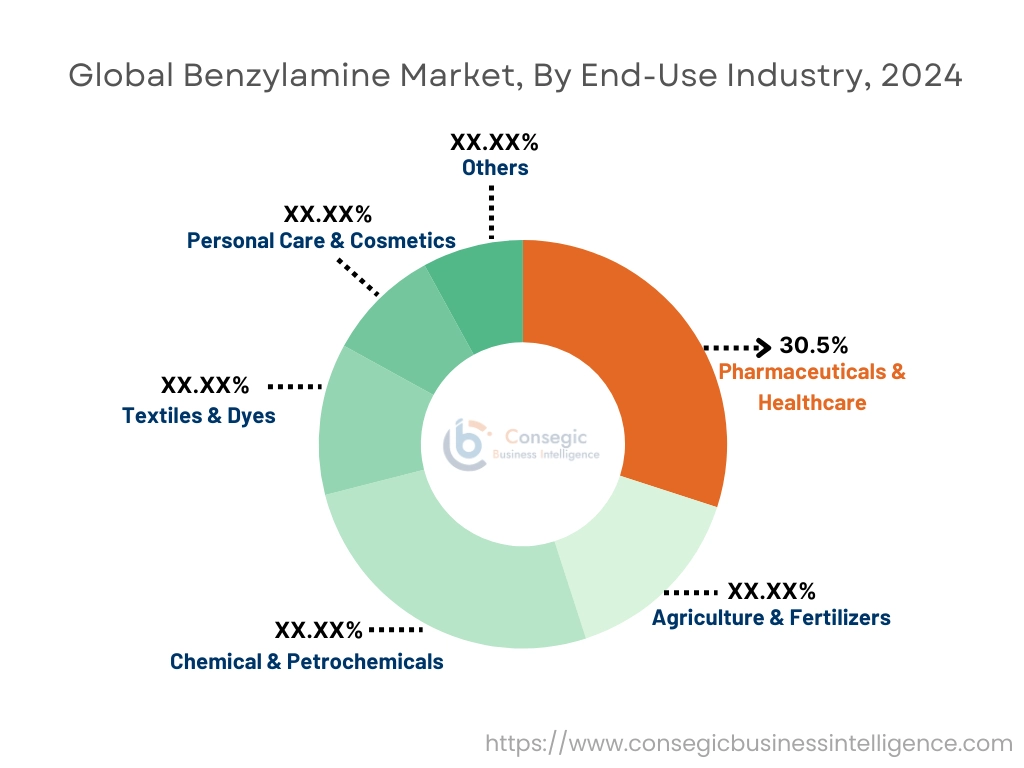
Regional Analysis:
The regions covered are North America, Europe, Asia Pacific, the Middle East and Africa, and Latin America.
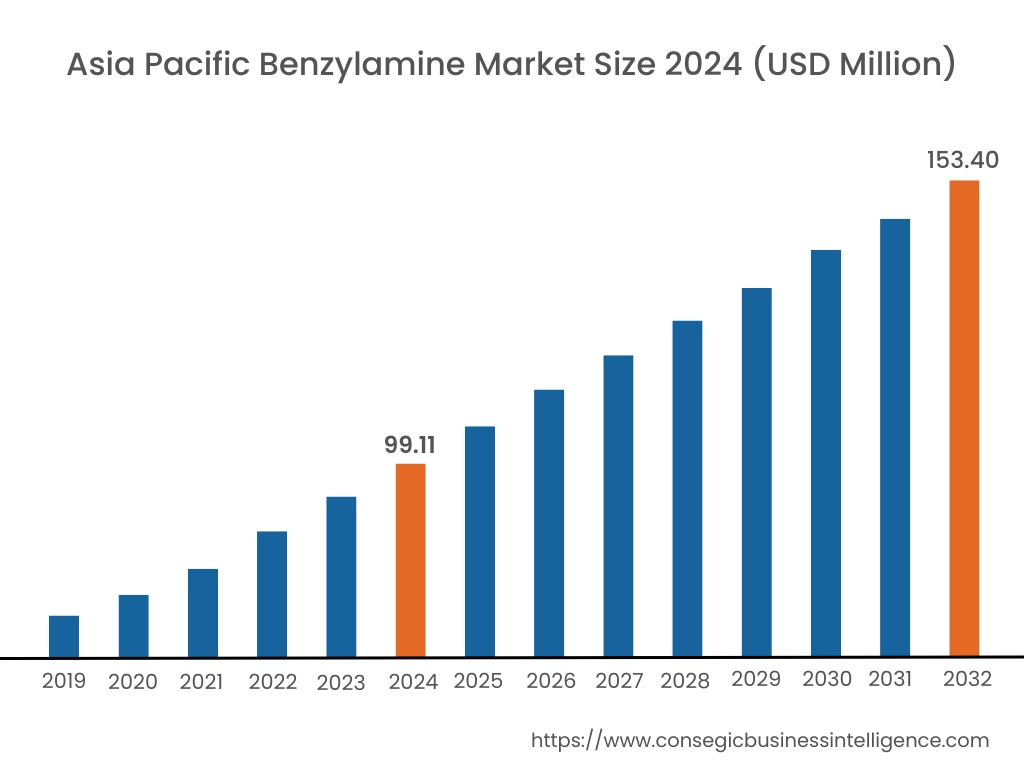
Asia-Pacific region was valued at USD 99.11 Million in 2024. Moreover, it is projected to grow by USD 102.73 Million in 2025 and reach over USD 153.40 Million by 2032. Out of this, China accounted for the maximum revenue share of 48.5%. The Asia-Pacific region is witnessing rapid growth in the benzylamine industry, primarily due to the burgeoning pharmaceutical and agrochemical sectors in countries such as China and India. The increasing population and urbanization lead to a higher need for pharmaceuticals and agricultural products, thereby boosting its application as a key intermediate. Economic development and industrialization further enhance the market prospects, presenting a significant benzylamine market opportunity for manufacturers aiming to expand their presence in this region.
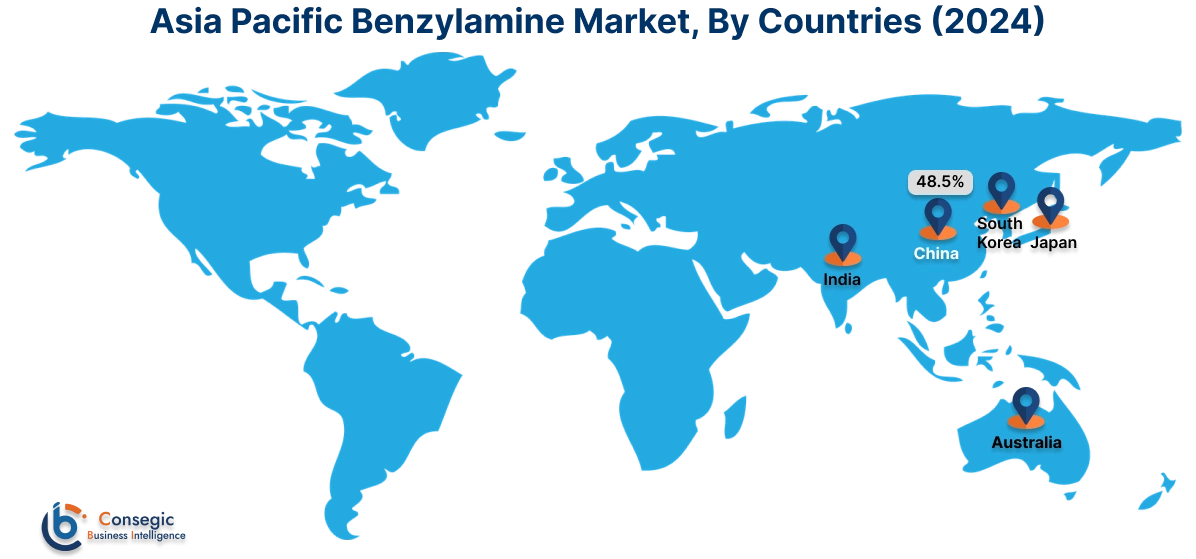
North America is estimated to reach over USD 136.62 Million by 2032 from a value of USD 89.74 Million in 2024 and is projected to grow by USD 92.88 Million in 2025. In North America, the benzylamine market is expanding due to the region's well-established pharmaceutical sector, which heavily relies on it as an intermediate in drug synthesis. The agrochemical sector also contributes to the requirement, utilizing the compound in the production of pesticides and fertilizers. The emphasis on research and development, coupled with advanced manufacturing techniques, positions North America as a significant player in the global benzylamine market.
Europe holds a substantial share of the benzylamine market, with countries like Germany, France, and the United Kingdom leading the growth. The region's robust chemical and pharmaceutical industries drive the need in various applications, including chemical synthesis and pharmaceutical manufacturing. The focus on sustainable practices and environmental regulations further influences the market dynamics, encouraging its adoption in eco-friendly applications.
In Latin America, the benzylamine market demand is gradually gaining traction, influenced by the growth of the agricultural sector and the rising need for effective agrochemicals. Countries like Brazil and Argentina are focusing on increasing agricultural productivity, which in turn drives the need for such pesticides and fertilizers. The chemical manufacturing sector also plays a role in market expansion, utilizing it in various synthesis processes.
The Middle East and Africa region has a burgeoning benzylamine market demand, with growth potential linked to the development of the pharmaceutical and agricultural sectors. The increasing focus on healthcare infrastructure and food security necessitates its use in drug formulation and agrochemical production. While challenges such as economic disparities and regulatory constraints exist, the market offers promising prospects as governments and organizations invest in industrial and agricultural development programs.
Top Key Players & Market Share Insights:
The benzylamine market is highly competitive with major players providing products and services to the national and international markets. Key players are adopting several strategies in research and development (R&D), product innovation, and end-user launches to hold a strong position in the global benzylamine market. Key players in the benzylamine industry include -
- LANXESS (Germany)
- BASF SE (Germany)
- IBIS Chemie International (India)
- Kingreat Chemistry Company Limited (China)
- CDH Fine Chemical (India)
- Mitsubishi Gas Chemical Company (Japan)
- Mita Chemicals Ltd. (Germany)
- Inchem GmbH (Germany)
- Klaus F. Meyer GmbH (Germany)
- INNOCHEM (Belgium)
Recent Industry Developments :
Product Launches:
- In March 2024, DCM Nouvelle Specialty Chemicals inaugurated a new chemical manufacturing plant in Madhya Pradesh, India. This facility produces cyclohexylamine (CHA), dicyclohexylamine (DCHA), benzylamine (BA) and dibenzylamine (DBA).
Benzylamine Market Report Insights:
| Report Attributes | Report Details |
| Study Timeline | 2019-2032 |
| Market Size in 2032 | USD 487.77 Million |
| CAGR (2025-2032) | 5.1% |
| By Purity Level |
|
| By Application |
|
| By End-Use Industry |
|
| By Region |
|
| Key Players |
|
| North America | U.S. Canada Mexico |
| Europe | U.K. Germany France Spain Italy Russia Benelux Rest of Europe |
| APAC | China South Korea Japan India Australia ASEAN Rest of Asia-Pacific |
| Middle East and Africa | GCC Turkey South Africa Rest of MEA |
| LATAM | Brazil Argentina Chile Rest of LATAM |
| Report Coverage |
|
Key Questions Answered in the Report
How big is the Benzylamine Market? +
Benzylamine Market size is estimated to reach over USD 487.77 Million by 2032 from a value of USD 328.65 Million in 2024 and is projected to grow by USD 339.42 Million in 2025, growing at a CAGR of 5.1% from 2025 to 2032.
What specific segmentation details are covered in the Benzylamine Market report? +
The Benzylamine market report includes specific segmentation details for purity level, application and end-use industry.
What are the end-use industry in the Benzylamine Market? +
The end-use industry of the Benzylamine market are pharmaceuticals & healthcare, agriculture & fertilizers, chemical & petrochemicals, textiles & dyes, personal care & cosmetics, others.
Who are the major players in the Benzylamine Market? +
The key participants in the Benzylamine market are LANXESS (Germany), BASF SE (Germany), Mitsubishi Gas Chemical Company (Japan), Mita Chemicals Ltd. (Germany), Inchem GmbH (Germany), Klaus F. Meyer GmbH (Germany), INNOCHEM (Belgium), IBIS Chemie International (India), Kingreat Chemistry Company Limited (China) and CDH Fine Chemical (India).
